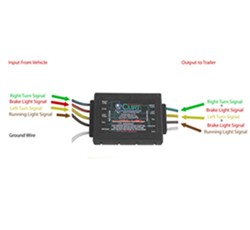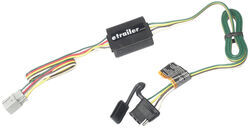
Replacing OEM Trailer Wiring Harness with # 118336 for 2004 Honda Pilot
Question:
Thanks for a well done site with good info. The install videos are cool. I have a 20004 Honda Pilot with dealer installed tow package. It suddenly gives no power less than 1V out the trailer connector thus, no lights. I read good voltage close to 12V out the connector to the car the factory installed plug -in inside the cargo area - the one you plug the wiring harness into. That one gives me close to 12V out the pins my owners manual indicates it should for each signal and light. On the output side of the converter box the 08L91-scv-1M000-01 Unit Trailer - the main component of my dealer installed wiring harness there are two 7.5 amp fuses and both were blown. Replacing them does not solve the problem - still no lights. Testing, I can get 12V across one of the fuse plugs output from the the box but nothing across the other. So I figure I need to replace the harness, and the box in particular. Im looking at your product as the likely replacement. Price for your wiring harness is about half that of an identical replacement for the part that failed. My questions: What does that converter box in the wiring harness do anyway? What might cause the box to fail? Your product is designed to run out the hatch when in use vice run through conduit to the outside and onto a bracket that holds the trailer plug on the tow bar... if I choose to run the trailer plug-in on your product through that conduit and mount it on the outside on that bracket, will I need to cut and rejoin the wires to the trailer plug-in? I have heard it said that storing the trailer plug in inside the vehicle as a pig tail as is done with your product is advantageous because it keeps the connectors out of weather when not in use that sounds logical to me... but then why do the factory and dealer installed harnesses have the plug outside?
asked by: Devin
Expert Reply:
Lets begin with the purpose of the converter box. The wiring system that trailers use is very simple. The turn signal and the brake lights are carried on the same circuit. The left turn and brake light signals are carried in the yellow wire down the drivers side of the trailer, and the right turn and brake light signals are carried on the green wire running down the passenger side. This is the tried-and-true system that has been used for years.
The converter comes in when you have a vehicle that uses a separate bulb (usually amber in color) that carries the turn signals. Because the brake light and turn signal are now carried on different circuits, the converter is used to combine the signals onto the same circuit, just like the wiring system the trailer uses. If you look at the photo of the converter box that I edited for you, you can see that there are more wires going into the input side than the output side.
We have a video that helps explain the combined-versus-separate wiring, click on the link.
The number one cause of converter failure is a wiring short on the trailer. At some point in your trailer wiring, the copper wire conductor has come into contact with the trailer frame, and creating a short circuit which in turn, damaged your converter box. Before proceeding with replacing the converter box, you will want to locate and repair the short in the trailer wiring. Trace each circuit back from the trailer connector, and follow each circuit back to the light fixture. Look for broken or pinched wires, or cracked or worn wire insulation.
I cannot speak to the factory practice of having the trailer connector attached to a bracket outside of the vehicle. I know from experience that having the connector inside the vehicle, protected from the elements is preferable. If you would prefer to run the trailer connector to the outside location, you can look on the underside of the vehicle for a grommet that could be used to pass through the connector under the vehicle. If one is present, it would usually be located in the cargo area floor, under the carpet. If the existing hole is too small to allow the connector to pass through it, the connector would have to be cut off and re spliced. You would want to cut and splice as close as possible to the converter, so that the splices remain in the vehicle, protected from the elements. Make sure that the area around the wire where it passes through the sheet metal is sealed with silicone, to prevent exhaust gas from entering the vehicle.
I have linked install instructions and an install video that you might find helpful.

Products Referenced in This Question
T-One Vehicle Wiring Harness with 4-Pole Flat Trailer Connector
- Custom Fit Vehicle Wiring
- Trailer Hitch Wiring
- Converter
- Custom Fit
- 4 Flat
- Tekonsha
more information >
Product Page this Question was Asked From
T-One Vehicle Wiring Harness with 4-Pole Flat Trailer Connector
- Custom Fit Vehicle Wiring
- Trailer Hitch Wiring
- Converter
- Custom Fit
- 4 Flat
- Tekonsha
more information >
Featured Help Information
Instructions
Miscellaneous Media

Continue Researching
- Q&A: Towing Capacity of 2005 Honda Pilot and Parts Needed to Tow Trailer
- Q&A: What is the Difference Between the Curt & Draw-Tite Trailer Hitches For a 2006 Honda CR-V
- Article: How to Choose the Right Trailer Hitch Class
- Article: My Trailer Hitch Doesn't Fit
- Q&A: What is the Difference Between a Class II and a Class III Hitch?
- Q&A: Recommended Wiring Harness for 2003 Honda CR-V With LED Tail Lights
- Article: How to Measure for Trailer Hitch Drop
- Article: Wiring Trailer Lights with a 4-Way Plug (It's Easier Than You Think)
- Article: Trailer Wiring Diagrams
- Q&A: What is the Difference Between a 4-Way and 7-Way Trailer Connector
- Q&A: Recommended Trailer Hitch Receiver, Wiring, And Ball Mount For 1998 Honda CR-V
- Q&A: Replacement Hardware Kit Availability for Draw-Tite Trailer Hitch # 24790 for a 2000 Honda CR-V
- Article: Brake Controller 7- and 4-Way Installation Kit (ETBC7)
- Article: Tow Bar Wiring: Which Wiring Kit is for You?







